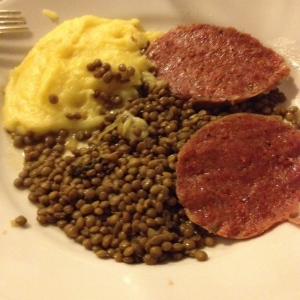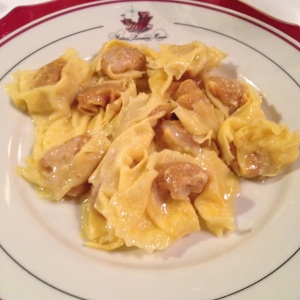I met Emidio Pepe, one of my favorite wine producers, a few times both in NYC and at Vinitaly, the wine fair in Verona, but I never had the chance to visit his winery in Abruzzo, even though I have been to the region many times. I started drinking Montepulciano d’Abruzzo many years ago with vintages from the 1970’s and they quickly became one of my favorite wines.
In early June I was invited on a press trip by the Consorzio Vini d’Abruzzo called the Abruzzo Wine Experience. It included visits to a number of wineries and one of them was the Emidio Pepe Winery. At last I would have my chance.
 When we arrived at the winery we were met by Emidio and his granddaughter Chiara De Julis. I had known Chiara as the public relations person for the winery in NYC.
When we arrived at the winery we were met by Emidio and his granddaughter Chiara De Julis. I had known Chiara as the public relations person for the winery in NYC.
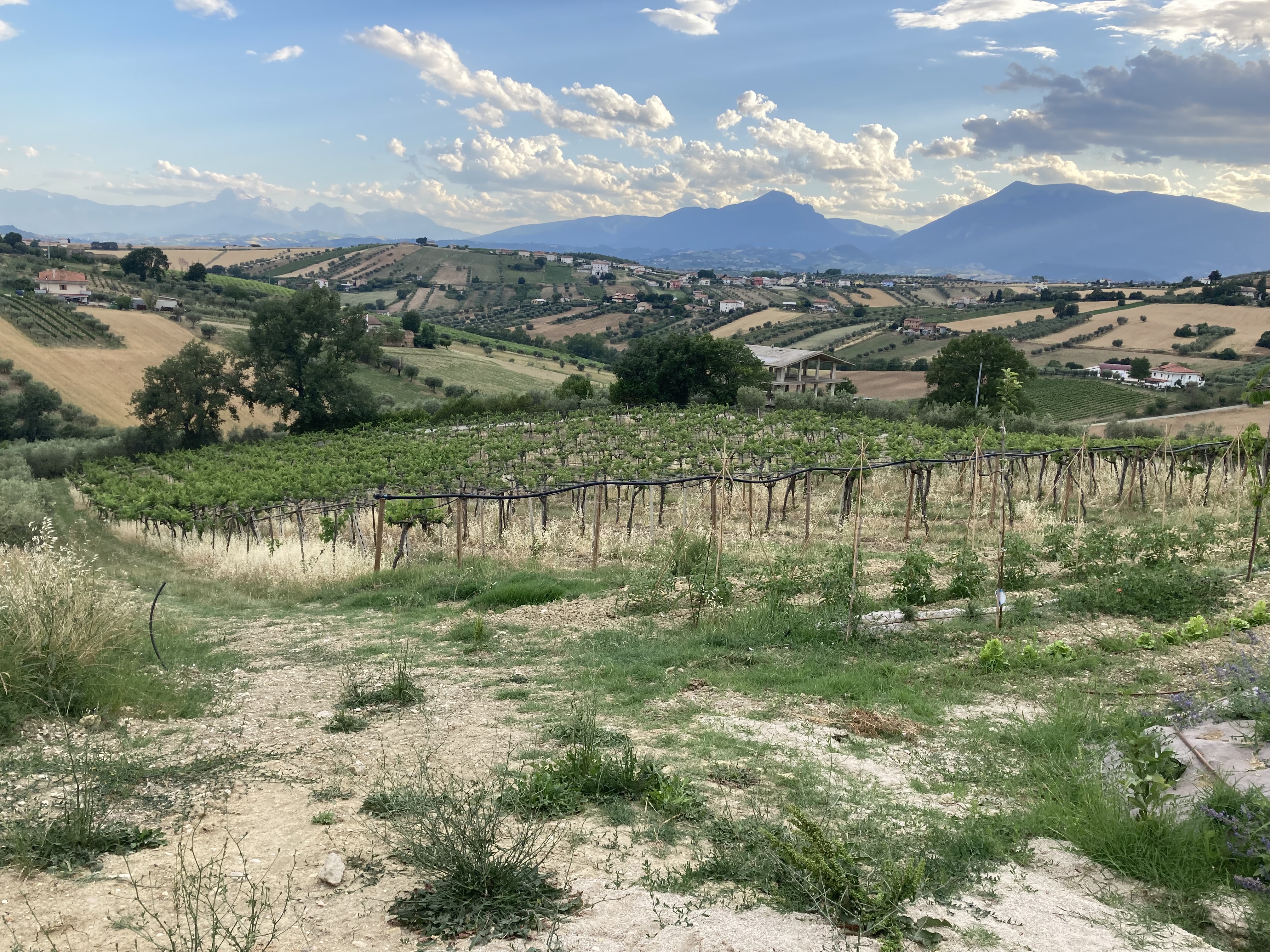 Chiara took the group to view the vineyards and spoke about the land. The soil is clay and limestone with the top 40 centimeters in clay on a solid layer of limestone. She said they use both the tendonne or pergola method for the Montepulciano and Trebbiano varieties and the cordon spur method for the Pecorino for training the vines. Chiara explained that “the pergola is like a solar panel to my grandfather: the greater sun exposure guarantees more photosynthesis so a ratio in favor of energy production and accumulation of reserves, keeping the evolution of the berries slow and gradual. The ripening of the Montepulciano under the shade of its leaves is the key to the elegance of its tannins; the pergola is the promise today, as an ancient visionary resolution facing today’s challenging climate.”
Chiara took the group to view the vineyards and spoke about the land. The soil is clay and limestone with the top 40 centimeters in clay on a solid layer of limestone. She said they use both the tendonne or pergola method for the Montepulciano and Trebbiano varieties and the cordon spur method for the Pecorino for training the vines. Chiara explained that “the pergola is like a solar panel to my grandfather: the greater sun exposure guarantees more photosynthesis so a ratio in favor of energy production and accumulation of reserves, keeping the evolution of the berries slow and gradual. The ripening of the Montepulciano under the shade of its leaves is the key to the elegance of its tannins; the pergola is the promise today, as an ancient visionary resolution facing today’s challenging climate.”
Chiara continued, “Our wines’ sense of place is strongly tied to the genetic complexity of the vegetal material which populates our vineyards. Emidio planted his first vineyards with the old method of field grafting. This practice – long lost – is to plant the rootstock, leaving its root system to dig deep in search of nourishments without worrying about the fruit. When ready, the plant is then grafted in the field, an operation that Emidio did himself after having selected and prepared every bud.”
According to Chiara, 1 hectare of tendonne has 900 vines and produces 90 quintals of grapes. That means that each vine produces from 6 to 9 kilos of grapes. In one hectare of cordon spur trained grapes, there are 3,300 vines and each vine produces 5 to 6 kilos of grapes.
After our tour, Chiara invited us to dinner.
 The dinner menu
The dinner menu
 Over dinner Chiara spoke about the wines. She began by telling us that her grandfather’s first bottled vintage was in 1964 and at that time he had only one hectare of vines. Today there are 17 hectares of vines near the Adriatic Sea that stretch out over the Teramo hills at the foot of the Gran Sasso Mountain.
Over dinner Chiara spoke about the wines. She began by telling us that her grandfather’s first bottled vintage was in 1964 and at that time he had only one hectare of vines. Today there are 17 hectares of vines near the Adriatic Sea that stretch out over the Teramo hills at the foot of the Gran Sasso Mountain.
The Emidio Pepe winery is Organic and Bio-Dynamic. They belong to the Triple “A”– Agriculturists Artisans Artists, an association of wine producers from around the world that believes in Organic and Bio-Dynamic production, terroir, and as little interference as possible by the winemaker in the winemaking process. Only natural yeasts are used. This gives the wine more complexity because there are so many different strains of yeast on the grapes and in the air.

The white grapes are pressed by feet in the wooden tub in the front and the red grapes by hand in the one in the back.
Trebbiano d’Abruzzo — the picking is exclusively by hand selecting only the perfect grapes. The white grapes are crushed by feet in a big wooden tub, 350kg at a time get crushed for 40-45 minutes, allowing a constant stimulation of skin with the juice, letting the skin release matter, flavors and aromas.
This method allows them to press the grapes in a delicate and soft way, not letting the stems break and producing a rich must ready to ferment. Only the juice goes to ferment in small concrete tanks, where spontaneous fermentation will start and go on for 30-35 days. From the concrete tanks, the second spring following the harvest, the wine will go straight into bottle to start its long improvement.
Montepulciano d’Abruzzo — the grapes are hand destemmed on a net on top of a wooden vat, two people push the grapes back and forth until the berries fall down and the stems remain on the net unbroken. This way only the elegant and juicy tannins of the skin will go into the must but not the bitter ones from the stems. The berries remain almost intact, important to keep the yeasts which are on the skins and really precious to the spontaneous fermentations.. No sulfites are added to the wine. The juice is placed in glass lined cement tanks of 20/25hl. The white remains here for one year and the red for two years. The wine is then transferred to bottles by hand.
The winery also produces a Cerasuolo (Rosé) which does not have any skin contact. It is made from the juice of the Montepulciano grapes which are pushed back and forth by hand.
 The wines made from the younger vines are released early for the Italian market. The wines made from the older vines are left in the winery to age and and then released on the international market. Chiara said the young vines do not have the the body or complexity to make to overseas journey.
The wines made from the younger vines are released early for the Italian market. The wines made from the older vines are left in the winery to age and and then released on the international market. Chiara said the young vines do not have the the body or complexity to make to overseas journey.
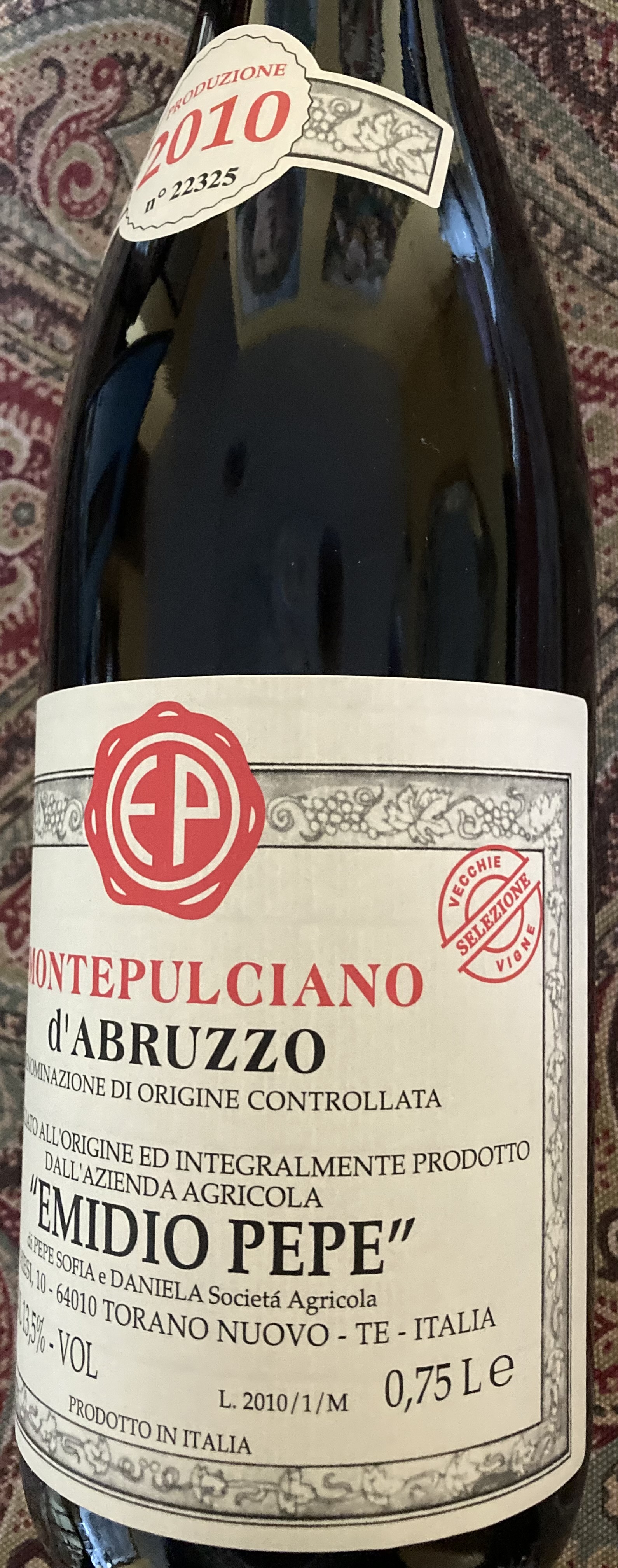 Starting in 2018 with the 2010 vintage, the aged wines will have Selizione Vecchie Vigne on the label.
Starting in 2018 with the 2010 vintage, the aged wines will have Selizione Vecchie Vigne on the label.
Chiara’s grandmother Rosa Pepe is in charge of the decanting process. Since this is a natural wine malolatic fermentation may take place in the tank or the bottle. There is no filtration or fining. The corks are placed in the bottles by hand and only the best cork is used. Chiara said that they guarantee all of the bottles have been decanted at the cellar after 20 years, no matter if the vintage is 2003 or 1983. The wine has to be well balanced and decanted to manage the trip and only their best wines are sent to the USA and put on the market.
About 60,000 bottles a year are produced. In an exceptional vintage they will hold back 70% of the production.
Chiara said that they have 600,000 bottles of wine from 1964 to the present vintage.
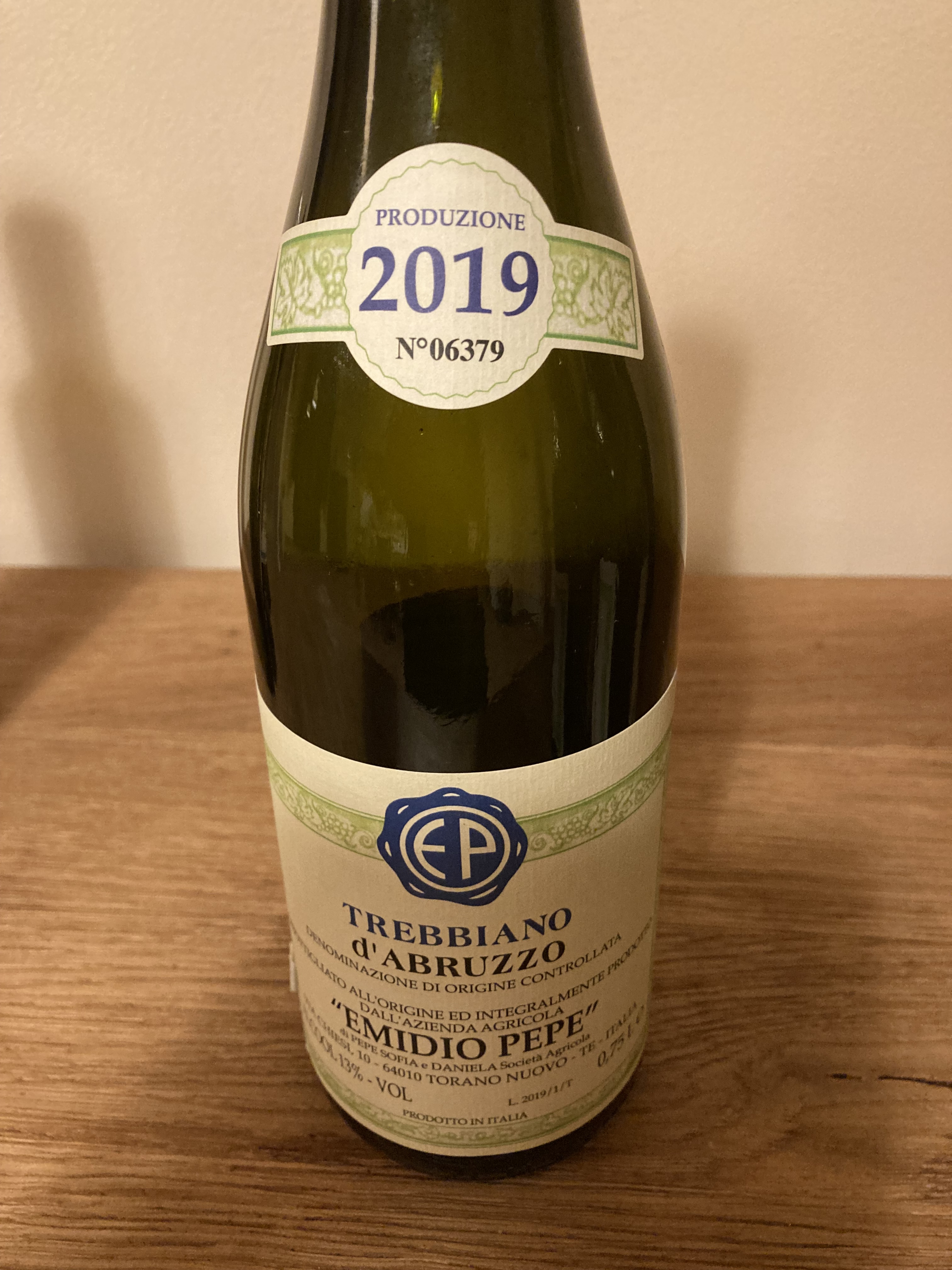 We tasted Trebbiano 2019, 2009, 2013, 2004 – While I like the older vintages I prefer the younger ones.
We tasted Trebbiano 2019, 2009, 2013, 2004 – While I like the older vintages I prefer the younger ones.
We tasted Montepulciano 1983, 2001, 2002, 2003, 2007- Recently in Rome I had the 2016 vintage and it was wonderful. However these are wines that can really age and their true greatness is expressed in the older vintages.
 The last wine we tasted was the 1983 Montepulciano D’ Abruzzo. Chiara said at first her grandfather did not like the 1983 vintage so he kept it in his cellar and did not sell it. A journalist came for a visit and asked why there was no 1983 on the market. When Emidio explained, the journalist asked if he could try it. Emidio agreed and they tasted it together. The wine had developed in the bottle and the two decided that it was a great wine in a great vintage. Emidio put 30% of the 1983 on the market. I was very happy Chiara let us taste this wine. I have had the 1963 a few times over the years and all I can say is that it is in a league of its own.
The last wine we tasted was the 1983 Montepulciano D’ Abruzzo. Chiara said at first her grandfather did not like the 1983 vintage so he kept it in his cellar and did not sell it. A journalist came for a visit and asked why there was no 1983 on the market. When Emidio explained, the journalist asked if he could try it. Emidio agreed and they tasted it together. The wine had developed in the bottle and the two decided that it was a great wine in a great vintage. Emidio put 30% of the 1983 on the market. I was very happy Chiara let us taste this wine. I have had the 1963 a few times over the years and all I can say is that it is in a league of its own.
I consider myself very fortunate to have been able to taste so many vintages of the great wines of Emidio Pepe all at one time.

 Meursault-Perrieres 2010 Premier Cru Jean Latour Labille &Fils made from 100% Chardonnay from a .175-hectare parcel planted in 1964. Fermentation and aging are in barrels, 50% new for 12 months then 4 months of additional aging in tank. This is a complex wine with hints of citrus fruit, melon, pear, a touch of honey and a note of brioche. I visited the winery in 2019 and really enjoyed all their wines.
Meursault-Perrieres 2010 Premier Cru Jean Latour Labille &Fils made from 100% Chardonnay from a .175-hectare parcel planted in 1964. Fermentation and aging are in barrels, 50% new for 12 months then 4 months of additional aging in tank. This is a complex wine with hints of citrus fruit, melon, pear, a touch of honey and a note of brioche. I visited the winery in 2019 and really enjoyed all their wines. We had a few little Appetizers to go with the wine. Some Castelvetrano olives, a mushroom pate from Michele’s book,
We had a few little Appetizers to go with the wine. Some Castelvetrano olives, a mushroom pate from Michele’s book,  Irpinia Aglianico 2016 “Memini” Az. Ag. Guastaferro made from 100% Aglianico. This wine bursts with sweet ripe fruit flavors of cherry, raspberry, strawberry and pomegranate. It has a wonderful fruit filled finish and a very long aftertaste. It was a very interesting Aglianico and I have never tasted one like this before. Daniele Cernilli (aka Doctor Wine) in his book The Essential Guide to Italian Wine 2020 states: “In 2002 Raffaele Guastaferro inherited 10 hectares from his grandfather with over 100 year old vines trained using the old starseto (pergola Avellinese) method…creating a very interesting style for the wines that were also based on tradition.”
Irpinia Aglianico 2016 “Memini” Az. Ag. Guastaferro made from 100% Aglianico. This wine bursts with sweet ripe fruit flavors of cherry, raspberry, strawberry and pomegranate. It has a wonderful fruit filled finish and a very long aftertaste. It was a very interesting Aglianico and I have never tasted one like this before. Daniele Cernilli (aka Doctor Wine) in his book The Essential Guide to Italian Wine 2020 states: “In 2002 Raffaele Guastaferro inherited 10 hectares from his grandfather with over 100 year old vines trained using the old starseto (pergola Avellinese) method…creating a very interesting style for the wines that were also based on tradition.” Pasta Amatrciana, my favorite with bucatini.
Pasta Amatrciana, my favorite with bucatini. On the plate, messy but so good.
On the plate, messy but so good. Montepulciano D’ Abruzzo 1985 Emidio Pepe100% Montepulciano D’Abruzzo. The winery is organic and Bio-Dynamic. They belong to the Triple “A” Agriculture Artisans Artists. Both the tendone method and the cordon spur method are used for training the vines. In vintages when the weather is very hot the tendone method is better because the leaves form a canopy to protect the grapes from the sun. When the weather is not too hot, the cordon spur is better because it allows more sun and air to reach the grapes. One hectare of tendone has 900 vines and produces 90 quintals of grapes. That means that each vine produces from 6 to 9 kilos of grapes. In one hectare of cordon spur trained grapes, there are 3,300 vines and each vine produces 5 to 6 kilos of grapes. The grapes are crushed by hand and the juice placed in glass-lined cement tanks of 20/25 liters. Only natural yeasts are used, there is no filtration or fining. The wine is transferred to the bottle by hand and the corks are placed in the bottles by hand. This is a very impressive wine with deep red fruit aromas and flavors with hints of cherry, spice and leather.
Montepulciano D’ Abruzzo 1985 Emidio Pepe100% Montepulciano D’Abruzzo. The winery is organic and Bio-Dynamic. They belong to the Triple “A” Agriculture Artisans Artists. Both the tendone method and the cordon spur method are used for training the vines. In vintages when the weather is very hot the tendone method is better because the leaves form a canopy to protect the grapes from the sun. When the weather is not too hot, the cordon spur is better because it allows more sun and air to reach the grapes. One hectare of tendone has 900 vines and produces 90 quintals of grapes. That means that each vine produces from 6 to 9 kilos of grapes. In one hectare of cordon spur trained grapes, there are 3,300 vines and each vine produces 5 to 6 kilos of grapes. The grapes are crushed by hand and the juice placed in glass-lined cement tanks of 20/25 liters. Only natural yeasts are used, there is no filtration or fining. The wine is transferred to the bottle by hand and the corks are placed in the bottles by hand. This is a very impressive wine with deep red fruit aromas and flavors with hints of cherry, spice and leather. Fried lamb chops, also from Michele’s book. The chops are coated with eggs, Parmigiano Reggiano and plain dry breadcrumbs. Here she used panko, which fries up nice and crunchy. Sorry for the photo, but we all grabbed some chops and started to eat before I could get a better shot!
Fried lamb chops, also from Michele’s book. The chops are coated with eggs, Parmigiano Reggiano and plain dry breadcrumbs. Here she used panko, which fries up nice and crunchy. Sorry for the photo, but we all grabbed some chops and started to eat before I could get a better shot! Dante’s Cheesecake is Michele’s version of a ricotta cheesecake that we used to enjoy at a favorite Greenwich Village Cafe.
Dante’s Cheesecake is Michele’s version of a ricotta cheesecake that we used to enjoy at a favorite Greenwich Village Cafe.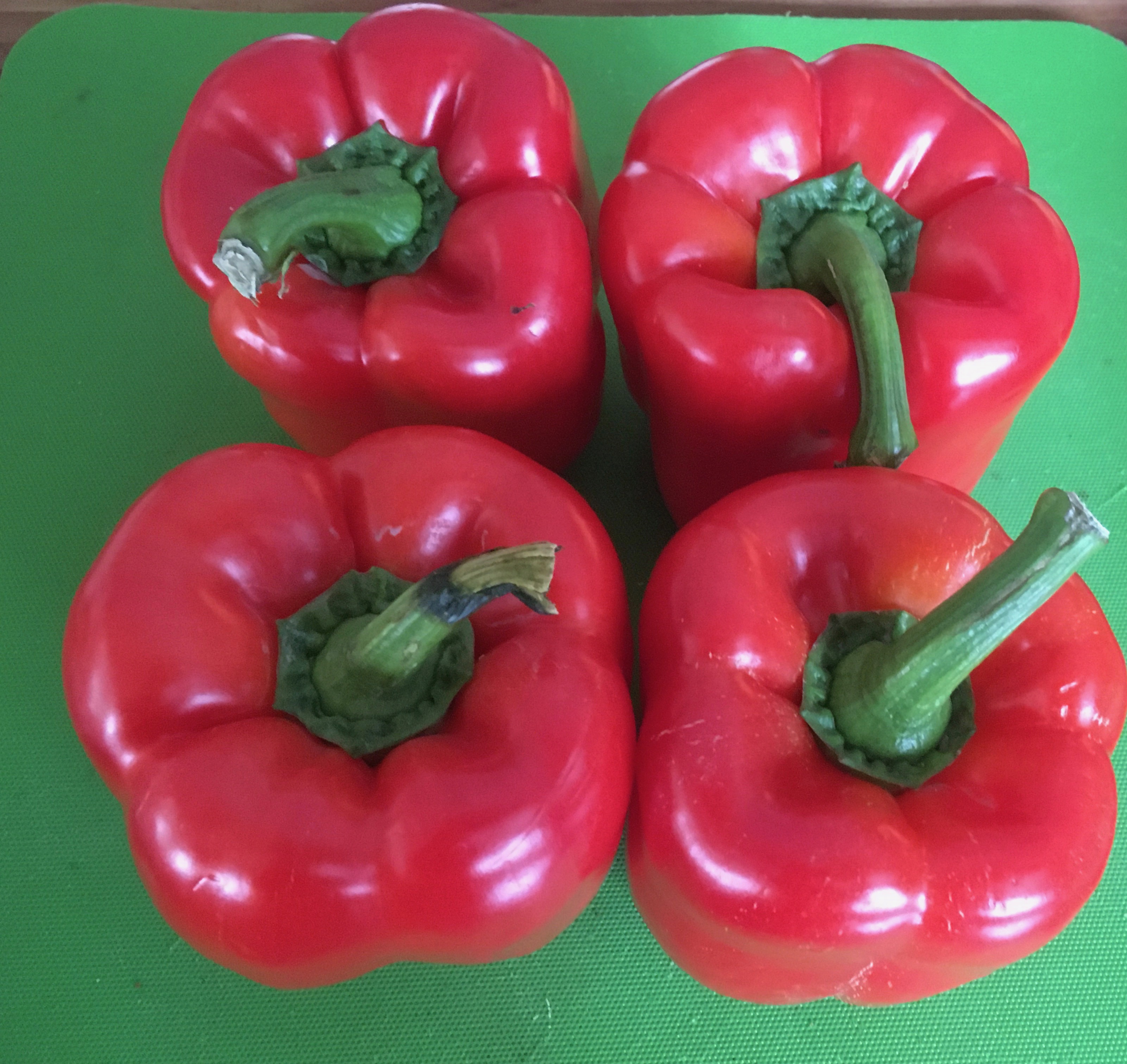 First, we had a little antipasto of marinated roasted red peppers. Here are the peppers ready to be cut
First, we had a little antipasto of marinated roasted red peppers. Here are the peppers ready to be cut After roasting and peeling, Michele marinated them with thick slices of garlic, olive oil and oregano. She leaves the garlic in large pieces so that it is easy to remove them. We ate the peppers with anchovies.
After roasting and peeling, Michele marinated them with thick slices of garlic, olive oil and oregano. She leaves the garlic in large pieces so that it is easy to remove them. We ate the peppers with anchovies. To go with the meatloaf, Michele made sauteed zucchini and onions with cherry tomatoes. She used canned cherry tomatoes. The secret of this recipe is to cook it just to the point where the zucchini are still firm and not mushy.
To go with the meatloaf, Michele made sauteed zucchini and onions with cherry tomatoes. She used canned cherry tomatoes. The secret of this recipe is to cook it just to the point where the zucchini are still firm and not mushy. The saucy vegetables were a nice complement to the meatloaf.
The saucy vegetables were a nice complement to the meatloaf. The meatloaf, called polpettone, is made mostly with beef, and some veal and pork ready mixed with chopped prosciutto, salami and cheese. Here it is ready for the oven
The meatloaf, called polpettone, is made mostly with beef, and some veal and pork ready mixed with chopped prosciutto, salami and cheese. Here it is ready for the oven The meatloaf out of the oven
The meatloaf out of the oven On the plate, the meatloaf was moist and full of flavor, complemented by the sauteed zucchini.
On the plate, the meatloaf was moist and full of flavor, complemented by the sauteed zucchini. Montepulciano D’ Abruzzo 2003 Emidio Pepe100% Montepulciano D’Abruzzo. The winery is organic and Bio-Dynamic. They belong to the Triple “A” Agriculture Artisans Artists. Both the tendone method and the cordon spur method are used for training the vines. In vintages when the weather is very hot the tendone method is better because the leaves form a canopy to protect the grapes from the sun. When the weather is not too hot, the cordon spur is better because it allows more sun and air to reach the grapes. One hectare of tendone has 900 vines and produces 90 quintals of grapes. That means that each vine produces from 6 to 9 kilos of grapes. In one hectare of cordon spur trained grapes, there are 3,300 vines and each vine produces 5 to 6 kilos of grapes. The grapes are crushed by hand and the juice placed in glass-lined cement tanks of 20/25 liters. Only natural yeasts are used, there is no filtration or fining. The wine is transferred to the bottle by hand and the corks are placed in the bottles by hand. This is a very impressive wine with deep red fruit aromas and flavors with hints of cherry, spice and leather. It is still young and will last for many years.
Montepulciano D’ Abruzzo 2003 Emidio Pepe100% Montepulciano D’Abruzzo. The winery is organic and Bio-Dynamic. They belong to the Triple “A” Agriculture Artisans Artists. Both the tendone method and the cordon spur method are used for training the vines. In vintages when the weather is very hot the tendone method is better because the leaves form a canopy to protect the grapes from the sun. When the weather is not too hot, the cordon spur is better because it allows more sun and air to reach the grapes. One hectare of tendone has 900 vines and produces 90 quintals of grapes. That means that each vine produces from 6 to 9 kilos of grapes. In one hectare of cordon spur trained grapes, there are 3,300 vines and each vine produces 5 to 6 kilos of grapes. The grapes are crushed by hand and the juice placed in glass-lined cement tanks of 20/25 liters. Only natural yeasts are used, there is no filtration or fining. The wine is transferred to the bottle by hand and the corks are placed in the bottles by hand. This is a very impressive wine with deep red fruit aromas and flavors with hints of cherry, spice and leather. It is still young and will last for many years.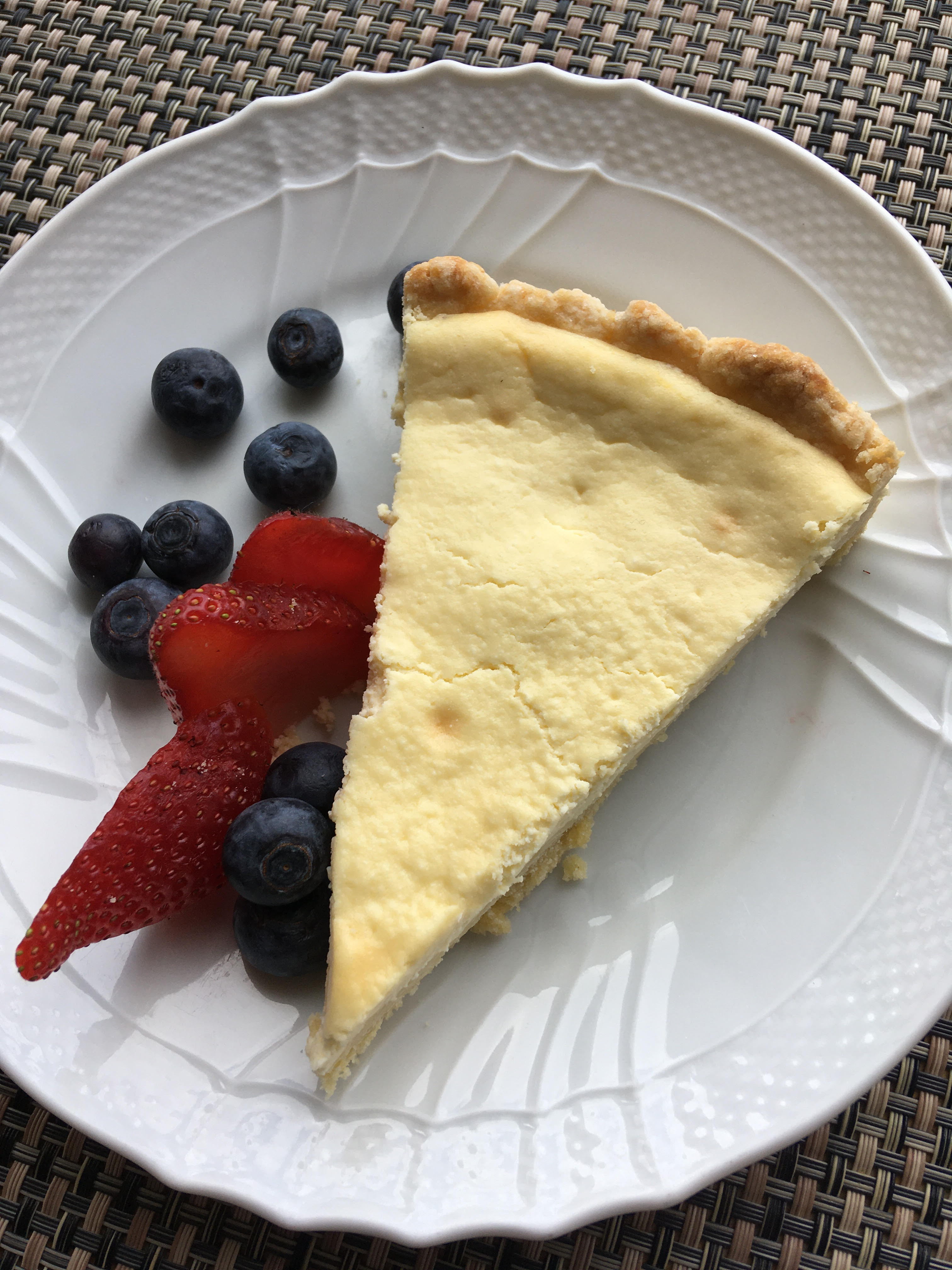 For Dessert, we had a Roman style cheesecake. The recipe is from Michele’s dessert book, La Dolce Vita.
For Dessert, we had a Roman style cheesecake. The recipe is from Michele’s dessert book, La Dolce Vita. 
 Michele made Ricotta Gnocchi with a simple tomato sauce from her book,
Michele made Ricotta Gnocchi with a simple tomato sauce from her book, 


 Chicken with Red Wine, Olives and Herbs ready to be served
Chicken with Red Wine, Olives and Herbs ready to be served On the plate
On the plate















































